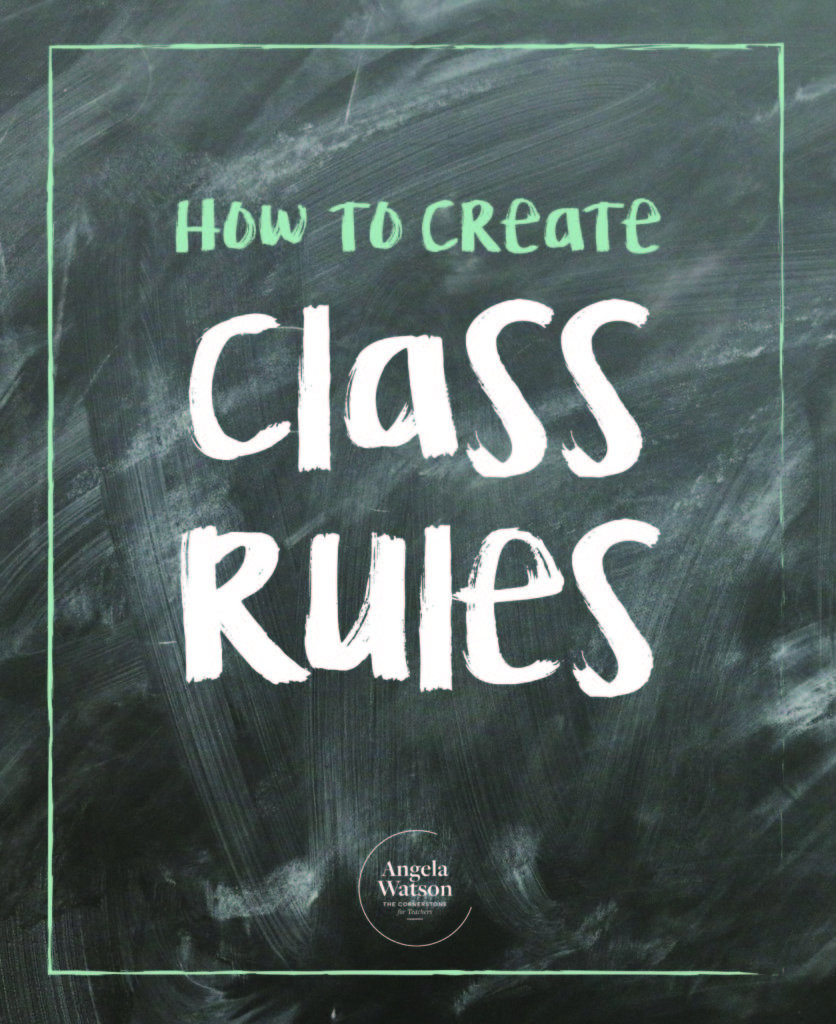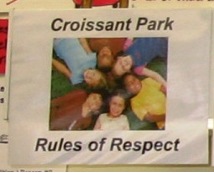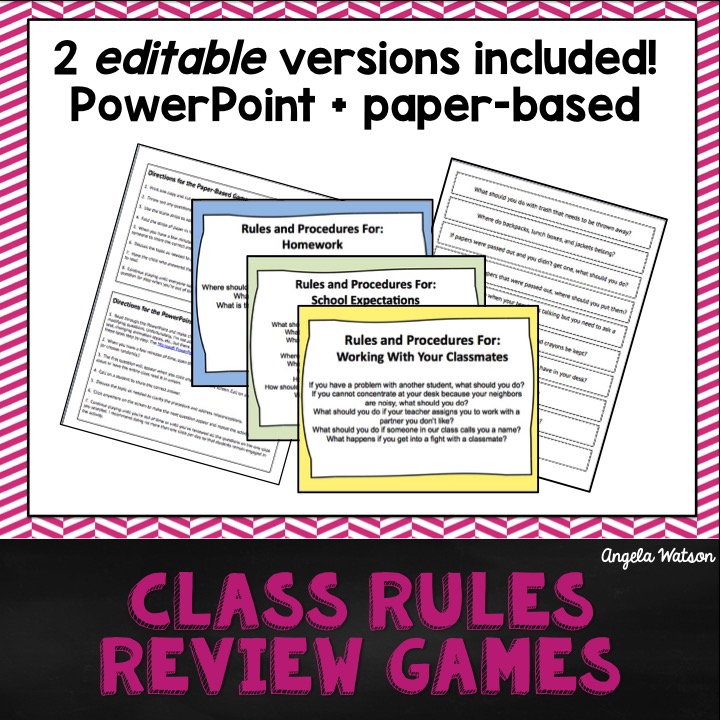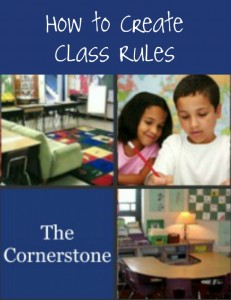Learn how to create classroom rules and support them through procedures, routines, and strong classroom management. This page (which is excerpted from The Cornerstone book) will help you create rules for the classroom and set the tone for positive classroom discipline.

Classroom rules vs. procedures
Let’s clarify what purpose rules serve and how they differ from routines. Rules set the tone for the classroom. They provide broad guidelines about what should or should not be happening as a whole in the classroom. Procedures and routines are specific steps that kids are supposed to take in specific scenarios.
A possible analogy for this difference can be made using our federal speed limit laws. The rule on a particular road may be for cars to go no more than 55 miles per hour. But the procedure is to keep an eye on your speedometer. The procedure is to keep both hands on the wheel and stay focused on the road ahead of you, not talking on a cell phone or listening to really loud music that will distract you from monitoring your speed. The procedure tells you how to be successful at keeping the rule. The procedure is practiced over and over until it is automatic. The rule will be broken and consequences will need to be enforced far less often if the procedure is practiced diligently.
Similarly, you will get better results with practicing how to line up quietly (over and over and over) than with saying, “Running in the classroom is against the rules”. Rules are what help set the general tone for your classroom, but routines are what keep your classroom running smoothly.
You will need rules so that students have a framework for the routines you set. Children should follow the routines for keeping their desks neat because that’s part of the rule about being a responsible student. They should follow the routines for passing in papers without disrupting othersbecause that’s part of the rule about respecting other people. They should follow the routines for raising their hands because that’s part of the rule about respecting the teacher.
Instead of rules, make goals
Another way to think about and explain rules is to set them as goals (i.e., Goal #1: Respect Yourself, Goal #2: Respect Others). The routines and procedures help children meet those goals successfully. If you phrase things this way with the children, the statement “Hitting is against the rules” changes to, “Our class goal is to be respectful to our friends. Hitting does not help us meet our goal.” Following the ‘rules’ then becomes a team effort to meet the goals that children agreed upon from the beginning of the year.
Setting class rules/goals

Some teachers like to make rules as a class. I’ve done that with great success, but if you know much about me, you’ve figured out that I like to do things differently every year so in recent years I have usually had the rules already made up. Normally I select three rules that pretty much cover everything from talking out to fighting to writing on desks.
- Respect yourself.
- Respect others.
- Respect the school [you could include “and everything in it”].
On the first day, we talk about the meaning of the word respect and create a chart describing what a respectful classroom looks and sounds like. We refer to the chart as needed during the first few weeks to analyze whether certain actions are respectful or disrespectful. Respect is usually a 30 minute lesson broken up into 2 days (15 minutes each day) but I have taught in places in which only one lesson was needed because most students came from homes in which parents had already instilled this value in their children.
If I feel like my class needs to explore the concept further, onthe second day I put scenarios on scraps of paper, have students draw them out of a box and read them, and we discuss. I try to choose situations that are ‘gray areas’ and not obvious to encourage high-level thinking, moral reason, and lots of group discussion! It gives me a good idea of who has the higher-order thinking skills in place and what their value systems are. We also talk about disrespect (a term that most of them are familiar with from home, music, etc.). They can easily name all the disrespectful behaviors that take place in the classroom, but need help brainstorming a list of alternative behaviors.

I taught at a school that had an awesome set of 5 “Rules of Respect” that I thought were perfectly phrased (the link allows you to download mini-posters I created for the rules: see photo above). These can serve as powerful classroom goals:
- I will reflect RESPECT.
- I will be a RESPONSIBLE student.
- I will display GOOD MANNERS.
- I will practice acts of KINDNESS.
- I will promise to ALWAYS DO MY BEST!
Working with district guidelines
Some schools already have a system of rules and consequences that they will expect you to use, such as check marks or tallies, which track misbehavior and enforce punishments such as time-out, filling out problem-solving sheets, missing recess, phone calls home, suspension, and so on. For legal and accountability purposes, I think these decisions are best made with your grade level team and administration, if they are not already mapped out by your school system. Some districts have general guidelines, which each grade level in the school modifies as appropriate, and meets to agree on the plan together. The rules and consequences are then signed by the principal, parents, and students, so that if problems arise, everyone already knows the expectations and consequences.
Choosing logical consequences
In general, consequences should be logical and related to the offense. It is typically more effective to tie a misbehavior to a natural consequence than a teacher-derived one. For example, if a student loses his crayons, he can’t color his paper. If a student continually disrupt the others around her, she should have to sit in a place where she can’t bother others. Logical consequences make sense to children, especially when explained calmly to them and enforced consistently. In a young child’s mind, pushing someone during reading groups is totally unrelated to missing recess at one o’clock. It would make more senseto have that child talk about what happened, and then move his/her chair apart from the group to keep the other children safe.
Punitive and rewards-based behavior management systems
In general, I do not recommend punitive behavior management systems. These are systems that follow the descending level model, in which students start out on ‘green’ and have increasingly severe consequences imposed on them when they make poor choices. These punitive systems do not typically reward students for good choices and only punish for bad ones, so that the only incentive for students to do well is to avoid punishment. If you do choose to have a punitive system, make sure you have also set up a simple but effective reinforcement system that rewards positive behavior, and explain it the first day. You may be able to tie it into your punitive system, but if the reward system is set up properly, you can rely on that much more heavily, rather than focusing on misbehavior. This does not have to complicated or time-consuming. I have created a Token System and a Bead System which I and many other teachers have used successfully, so feel free to visit those two pages if you would like some ideas to modify for your own classroom. Also check out the 5 Pro-Active Strategies page for guidelines on how to handle misbehavior and book recommendations specifically designed to help you set expectations–they’re great to read when creating class rules.
Reviewing and reinforcing rules throughout the school year
I use the Class Rules Review Game shown above which includes a paper-based game and a PowerPoint game. Because the games only provide the questions and not the answers, I can change and adapt my rules and routines throughout the year without having to change the games.


Angela Watson
Founder and Writer
Discussion
Leave a Reply
OR

Join our
community
of educators
If you are a teacher who is interested in contributing to the Truth for Teachers website, please click here for more information.
















Hi, I was surfing the web and washed ashore on your site. What a wonderful place to be!!! There is enough information that I will still be reading at Christmas===thank you for sharing. I have a question, I was in a math section that you did take home things and you said a person named Jennifer Bond had done a great with job with first and second grade. You have her site that I saw, twice—-something is wrong with the link. Do you know of a way I can get to her link for math. I teach second grade and would love to see her ideas. Thank you–Sally
Hi, Sally! The link seems to be working fine for me. Try it here:
http://teacherweb.com/MO/MillsElementary/MrsBondsFantasticFirstGraders/apt3.aspx
Hope you can visit her site–it’s fabulous!
Thanks for the 5 Rules printable. I love that I can edit for font/size to make it fit my classroom space! Much appreciate it!
You’re welcome, Chris!
I used examples from you site today and found them to be extremely helpful. However, I wanted to know what type of scenarios you used on the slips of paper for instances of disrespectful behavior? Any help would be greatly appreciated. Thanks!
Hi, Johanna! That’s great to hear. The scenarios I used were ones that I had noticed in my classroom: students calling out, pushing in line, calling each other names, etc. You can base your scenarios on the issues that your students are dealing with.